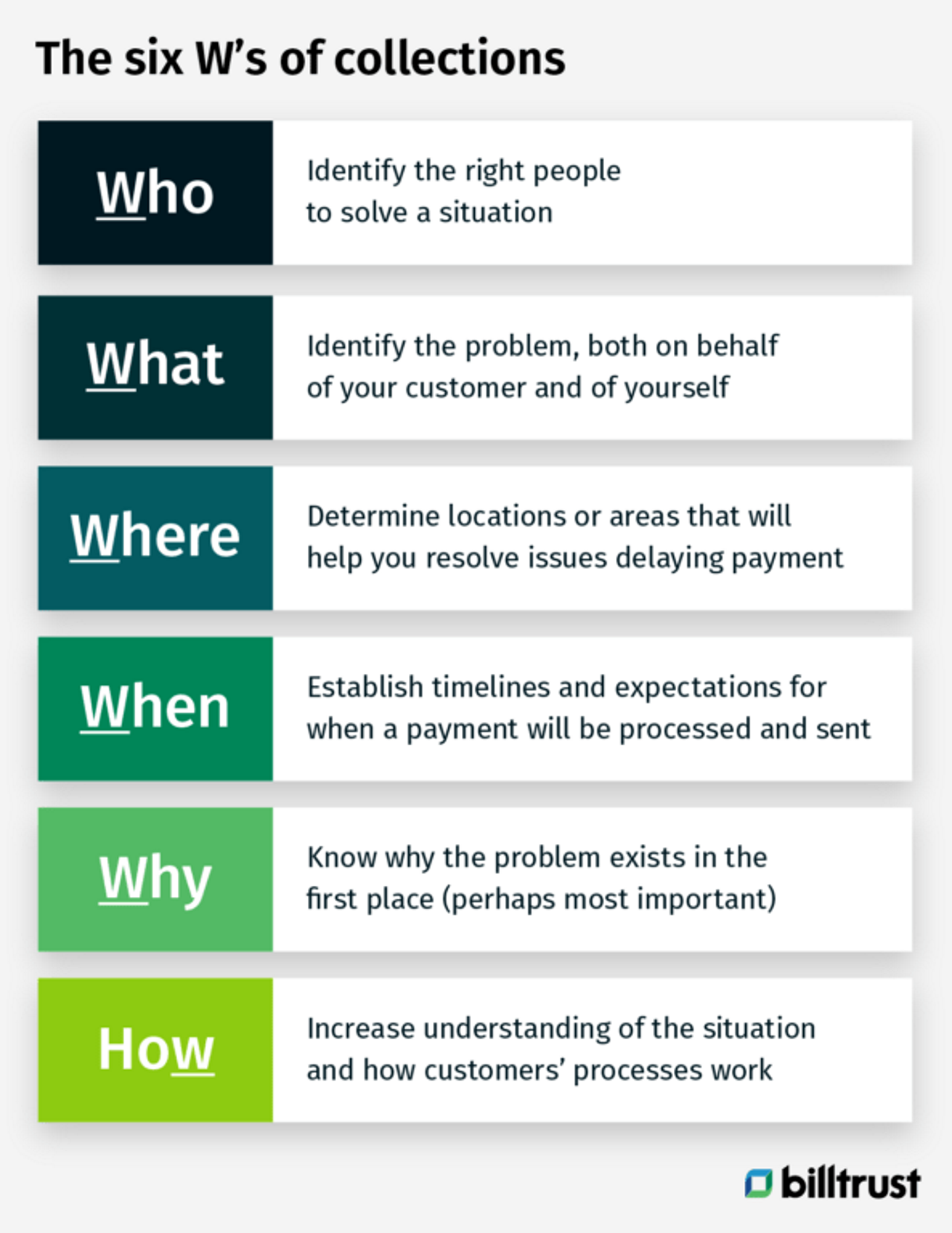What do collectors have in common with detectives?
Have you ever watched a crime drama? A suspect sits in front of detectives with a glaring light shining in their face as beads of sweat start to slowly form. The detectives ask question after question. Sometimes the detectives are tense and forceful with their questions, other times friendlier and softer. Their goal is to get to the truth.
That scenario is not that different from a contact you may have with your customer. Sure, the stakes aren’t as high and nowhere near as dramatic, but essentially your motives and means aren’t that different. You are trying to get as much information as you can from your contact.
In a previous whitepaper, I spoke of all the different roles a professional collector plays. Two I didn’t mention were those of investigator and interrogator. As such, one of the biggest tools you have as a professional collector are the 6 W’s.

The 6W's of collections
For those of you not familiar with the six W’s they are: Who, What, Where, When, Why and hoW and are basic to information gathering and problem solving. Attributed to Aristotle’s “Nicomachean Ethics” which dates to 340 BC, the six W’s are a formula to get a complete story on a subject and are used in journalism, research and police investigations. By using them, you can make sure every contact you make with a customer is a quality one.
Collectors can make a lot of contacts during the day, but that doesn’t ensure you will collect money or resolve an issue to procure payment. On the flip side, you cannot have a contact that takes too much time, because it will affect your ability to penetrate your portfolio. Collections is a balancing act between quantity and quality.
The truth is, a quality collection call can lead to fewer contacts with the same customer. Using the Six W’s, you can get all your answers in one contact and lessen the need to call your customer additional times. The last thing you want is to make multiple calls about the same issue because you neglected to get all the relevant information the first time. The Six W’s are open-ended questions and cannot be answered with a simple yes or no.

Ask the 6 W's when collecting
By asking Who, you can help identify the right people to resolve a situation. If your contact claims that checks are cut on a certain day and you need payment previous to that day, finding out who has the power to authorize a payment can lead you to getting paid sooner. How many times has a customer claimed they are working with someone from your company to resolve an issue? By asking who, you now know whom within your organization you can get resolution status updates
What
What allows you to identify the problem and is not only a question to ask your customer, but one to ask yourself. Even before you pick up a phone or begin to type an email, it always pays to ask yourself what you’re trying to accomplish with this contact. This will keep your contacts focused and concise. Also, when you have a customer on the phone and are discussing past due, looking at what is coming due in the next several days and asking about those invoices can help get them remitted quicker or identify issues earlier.
Where
Where is all about determining locations or areas that will help you resolve the issues that may be delaying payment. For instance, knowing from where your customer’s payments are generated is very important. If they are generated from a different location than where your contact is located, then your payment may be delayed further. That payment may have been approved by your contact but then has to go to another location to be generated. Where do you go to get further information to get an invoice paid or a dispute resolved? It may be the customer’s PO or maybe the contract. Each could have important details you may need.
When
When is a question that establishes timelines and expectations. The most obvious is identifying when a payment will not only be processed but when it will be made or sent. Many times a professional collector will be told invoices won’t be paid until a return is made. Establishing when the product will be returned will help you understand the timeline of when a payment will eventually be made. Having the customer commit to when they will have an answer or an update to a particular issue allows you to establish an expectation from them.
Why
Although all the W’s are important, Why might be the most critical. Knowing why a problem exists goes a long way to resolving it and influences your decision making. If the why behind a payment not being made is because the company is struggling financially, that can affect future business decisions with that customer. Finding out why there are discrepancies that are withholding payment allows you to resolve them and get payment remitted.
hoW
By getting answers to hoW, we increase our understanding of the situation and how some of our customer’s processes work. A great “how” question example is, “How are payments made?” By knowing this you can get a better understanding of when you can expect to receive that payment. Knowing how a customer’s payment approval process works let’s you know to whom you may have to escalate a situation or what is holding up resolution.

Professional collectors know what is going on with a customer’s accounts receivables
The six W’s have been around for over 2,300 years because it works, allowing you to get complete information and guide you towards the answers you need to resolve any problems.
A professional collector needs to know what is going on with a customer’s receivables. They need to know what is getting paid and the “why” or “what” issues preventing payment. As a collector, you cannot guarantee you are going to get a customer on the phone a second time. You don’t know if they will answer your follow-up email or your follow-up to your follow-up email.
Every contact with a customer is important and should not be wasted. By following the six W’s, you can make sure you get the most out of each contact. Because they are open-ended questions, a customer can’t cut off the conversation with a simple yes or no. It will also allow you to keep your management and internal customers up to date and informed on any issues. By using the six W’s, you will be able to satisfy both the quantity and quality of your contacts.
Continue the conversation about collections training
To learn more about how Professional Collections Training can impact your business, fill out the contact form and a Billtrust expert will be in touch with you soon.
About John
John Floyd is the Senior Business Consultant for Billtrust, supporting customers to implement collections solutions and optimize their environment to reduce DSO and delinquency. With 20+ years of experience in credit and collections, John has held the positions of Credit Analyst, Risk Compliance Analyst, Analyst - Order to Cash, Credit and Collections Supervisor, Credit Analyst and Collections. He has managed in-house and outsourced collections teams. In his career, John has created policies and procedures, as well as correspondences (I.E. dunning letters, final demand letters, credit applications, payments plans) for multiple companies.

